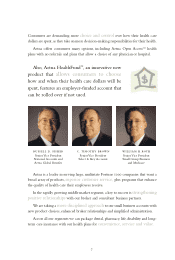Aetna 2001 Annual Report Download - page 19
Download and view the complete annual report
Please find page 19 of the 2001 Aetna annual report below. You can navigate through the pages in the report by either clicking on the pages listed below, or by using the keyword search tool below to find specific information within the annual report.
Bioterrorism: A Challenge to
Health and Security
. , ..
Vice President for Biological Programs, NTI
The tragic events this past fall brought new attention to
our nation’s vulnerability to terrorism, including bioterrorism.
Few today are complacent about the possibility that a biological agent might be intentionally used to
cause widespread panic, disruption, disease and death. As we mobilize to address an array of national
security threats, a comprehensive program to counter and prevent bioterrorism must rank high on
the priority list.
Bioterrorism differs fundamentally from other terrorist threats. Most likely it would unfold
as an infectious disease epidemic, spread in time and place before authorities even realize that an
attack has occurred. In fact, it may prove difficult to ever identify the perpetrators, the site of release,
or even determine whether the outbreak was natural or intentional.
In most scenarios, diagnosis will be delayed because medical providers and laboratories would
not readily recognize the disease agents of concern. Further,medical interventions may be limited, and
the window of opportunity for their delivery narrow. Because of ongoing contagion or continuing
exposure, disease might persist over a prolonged period.
The potential devastation is extraordinary, but unlike other weapons of mass destruction, biological
weapons are relatively easy to produce, inexpensive; and significant damage can be done even
without large quantities of material or an elaborate delivery mechanism.
So what can be done? First, we must recognize that public health is an essential component of
our national security framework. Long neglected, our public health system to detect, track and
contain infectious disease requires urgent attention. Resources are needed to strengthen and extend
surveillance systems, enhance laboratory facilities, and improve communication.
In addition, we must prepare for the possibility of a sudden surge of patients in the health care
system. Careful advance planning is needed, since most hospitals now are operating at or near
capacity. Furthermore, release of a biological weapon may require rapid access to quantities of
antibiotics, vaccines or antidotes not routinely available. A national stockpile now exists, but needs
augmentation, including plans for swift, on-the-ground distribution and extra production capability.
Additional investments in basic and applied research to develop new drugs, vaccines, rapid
diagnostics and other medical weapons will add to the arsenal against bioterrorism. An effective
research agenda may someday provide the tools to render the threat of biological weapons obsolete.
Finally, prevention must be a primary goal. Improved information about potential threats is key.
For bioterrorism, this requires new partnerships between law enforcement, intelligence agencies,
and the public health and scientific communities.
Sadly, we must recognize the possibility of bioweapons threats emerging from legitimate research.
Can we prevent the tools of modern biology from being misused to create new, more dangerous
pathogens? Reducing access to dangerous pathogens will also require enhanced efforts by the scientific
community to improve laboratory security and assure safe storage and handling.
Bioterrorism confronts us with extraordinary challenges, yet there is a clear path for meaningful
action. Moreover, investments made to strengthen public health, improve medical management and
support research will greatly benefit protection against outbreaks of naturallyoccurring infectious disease.
























